Complementary and Alternative Medicine for LBP in Australia Essay
VerifiedAdded on 2023/04/03
|11
|2735
|303
Essay
AI Summary
This essay provides a comprehensive overview of the use of complementary and alternative medicine (CAM) for the treatment of low back pain (LBP) in Australia, targeting healthcare professionals as the primary audience. It explores the prevalence of LBP, its causes, and the limitations of conventional treatments. The essay delves into various CAM therapies, including acupuncture, massage, spinal manipulation, and neuroreflexotherapy, discussing their mechanisms of action, evidence of effectiveness, and comparisons with conventional treatments. It also covers the challenges and considerations surrounding CAM use, offering insights into the potential benefits and limitations of these approaches. The essay emphasizes the importance of healthcare professionals understanding and considering CAM options to provide comprehensive and patient-centered care. The essay concludes with a summary of the findings and recommendations for healthcare professionals regarding the use of CAM for LBP.
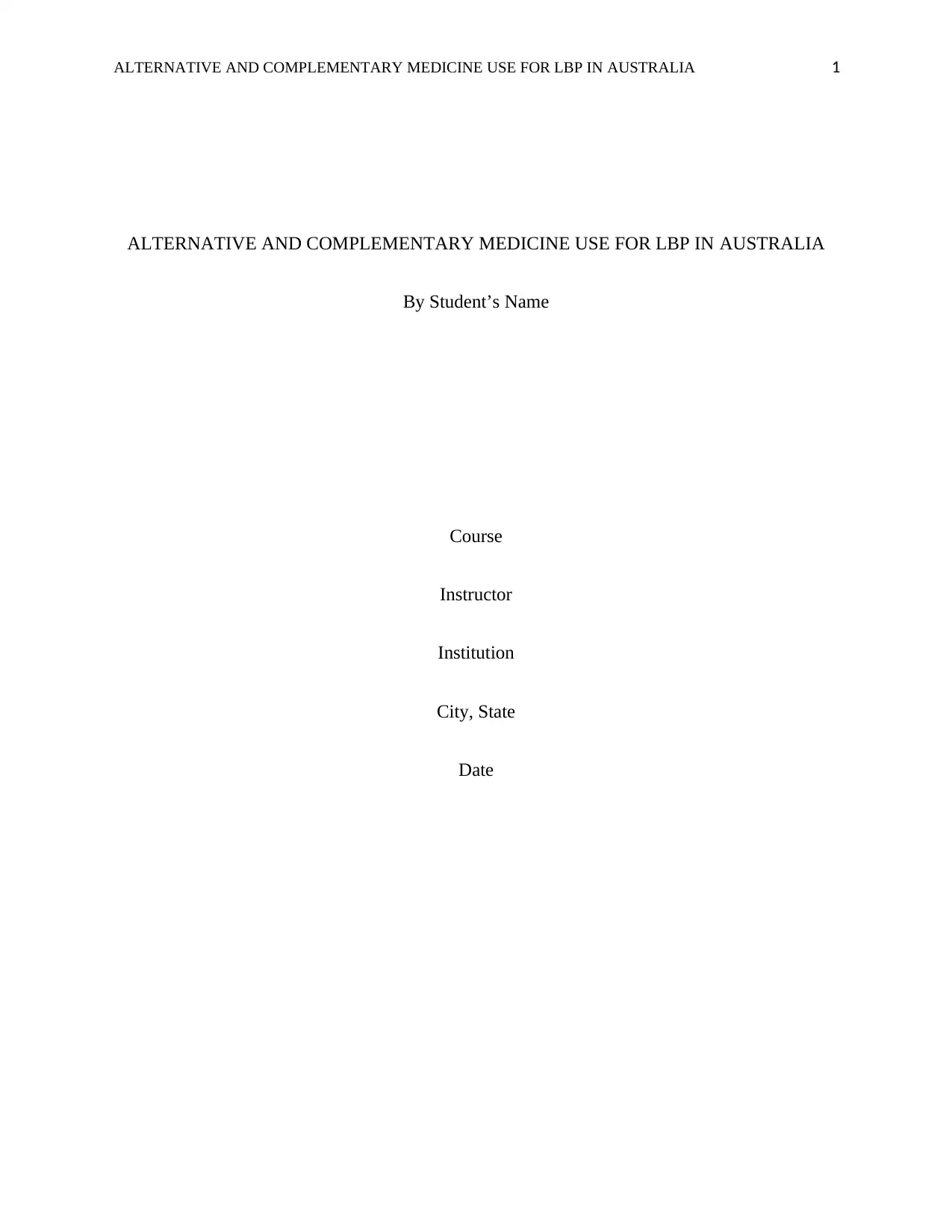
ALTERNATIVE AND COMPLEMENTARY MEDICINE USE FOR LBP IN AUSTRALIA 1
ALTERNATIVE AND COMPLEMENTARY MEDICINE USE FOR LBP IN AUSTRALIA
By Student’s Name
Course
Instructor
Institution
City, State
Date
ALTERNATIVE AND COMPLEMENTARY MEDICINE USE FOR LBP IN AUSTRALIA
By Student’s Name
Course
Instructor
Institution
City, State
Date
Paraphrase This Document
Need a fresh take? Get an instant paraphrase of this document with our AI Paraphraser
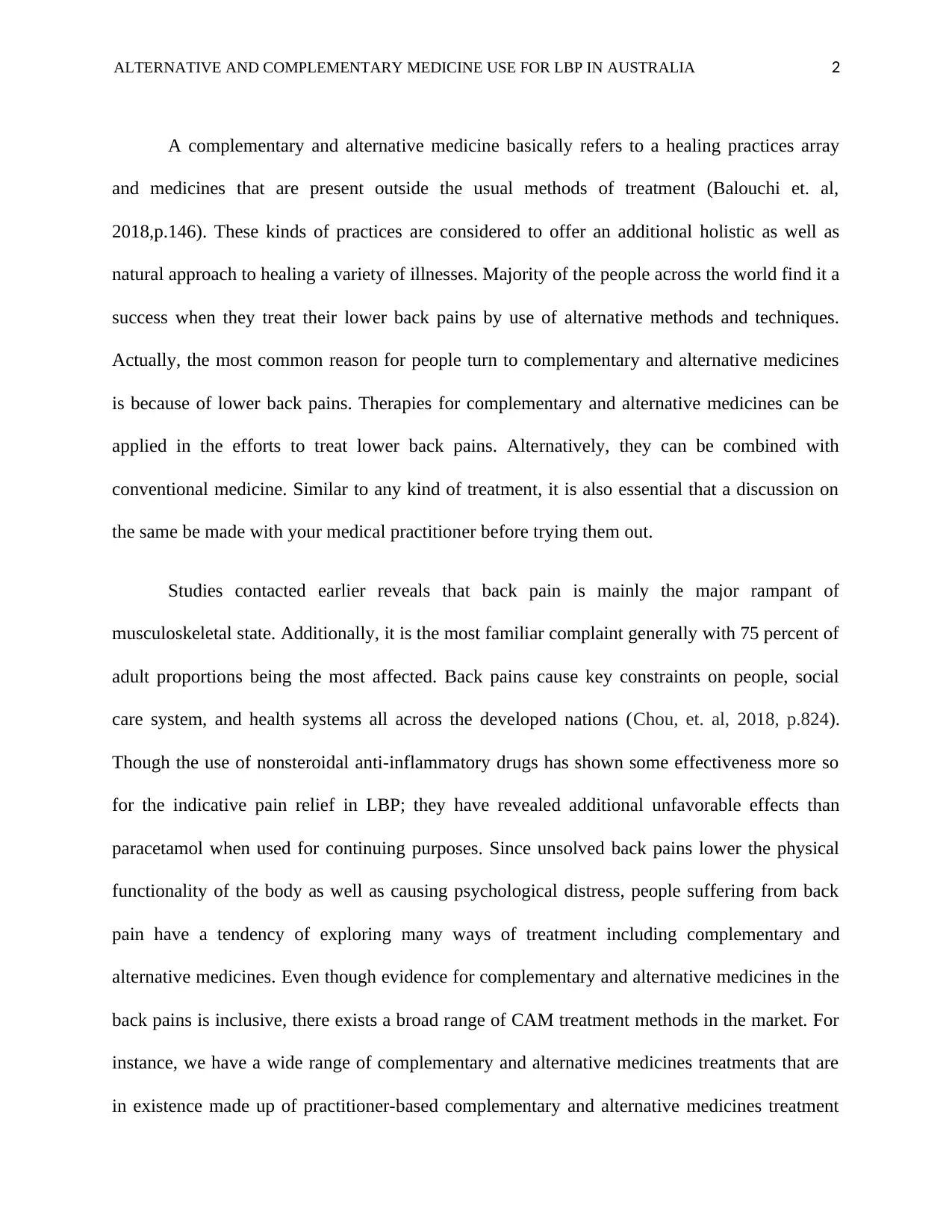
ALTERNATIVE AND COMPLEMENTARY MEDICINE USE FOR LBP IN AUSTRALIA 2
A complementary and alternative medicine basically refers to a healing practices array
and medicines that are present outside the usual methods of treatment (Balouchi et. al,
2018,p.146). These kinds of practices are considered to offer an additional holistic as well as
natural approach to healing a variety of illnesses. Majority of the people across the world find it a
success when they treat their lower back pains by use of alternative methods and techniques.
Actually, the most common reason for people turn to complementary and alternative medicines
is because of lower back pains. Therapies for complementary and alternative medicines can be
applied in the efforts to treat lower back pains. Alternatively, they can be combined with
conventional medicine. Similar to any kind of treatment, it is also essential that a discussion on
the same be made with your medical practitioner before trying them out.
Studies contacted earlier reveals that back pain is mainly the major rampant of
musculoskeletal state. Additionally, it is the most familiar complaint generally with 75 percent of
adult proportions being the most affected. Back pains cause key constraints on people, social
care system, and health systems all across the developed nations (Chou, et. al, 2018, p.824).
Though the use of nonsteroidal anti-inflammatory drugs has shown some effectiveness more so
for the indicative pain relief in LBP; they have revealed additional unfavorable effects than
paracetamol when used for continuing purposes. Since unsolved back pains lower the physical
functionality of the body as well as causing psychological distress, people suffering from back
pain have a tendency of exploring many ways of treatment including complementary and
alternative medicines. Even though evidence for complementary and alternative medicines in the
back pains is inclusive, there exists a broad range of CAM treatment methods in the market. For
instance, we have a wide range of complementary and alternative medicines treatments that are
in existence made up of practitioner-based complementary and alternative medicines treatment
A complementary and alternative medicine basically refers to a healing practices array
and medicines that are present outside the usual methods of treatment (Balouchi et. al,
2018,p.146). These kinds of practices are considered to offer an additional holistic as well as
natural approach to healing a variety of illnesses. Majority of the people across the world find it a
success when they treat their lower back pains by use of alternative methods and techniques.
Actually, the most common reason for people turn to complementary and alternative medicines
is because of lower back pains. Therapies for complementary and alternative medicines can be
applied in the efforts to treat lower back pains. Alternatively, they can be combined with
conventional medicine. Similar to any kind of treatment, it is also essential that a discussion on
the same be made with your medical practitioner before trying them out.
Studies contacted earlier reveals that back pain is mainly the major rampant of
musculoskeletal state. Additionally, it is the most familiar complaint generally with 75 percent of
adult proportions being the most affected. Back pains cause key constraints on people, social
care system, and health systems all across the developed nations (Chou, et. al, 2018, p.824).
Though the use of nonsteroidal anti-inflammatory drugs has shown some effectiveness more so
for the indicative pain relief in LBP; they have revealed additional unfavorable effects than
paracetamol when used for continuing purposes. Since unsolved back pains lower the physical
functionality of the body as well as causing psychological distress, people suffering from back
pain have a tendency of exploring many ways of treatment including complementary and
alternative medicines. Even though evidence for complementary and alternative medicines in the
back pains is inclusive, there exists a broad range of CAM treatment methods in the market. For
instance, we have a wide range of complementary and alternative medicines treatments that are
in existence made up of practitioner-based complementary and alternative medicines treatment
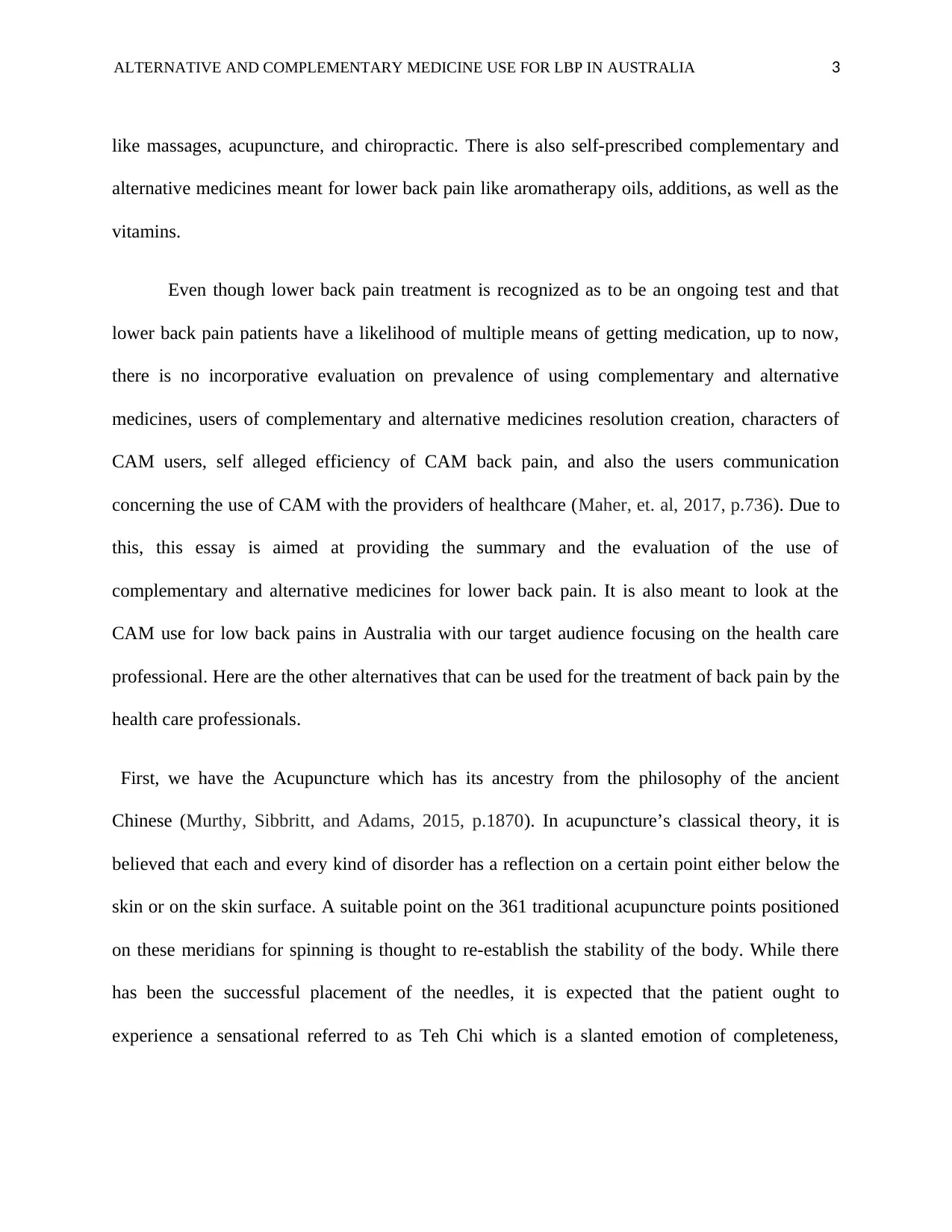
ALTERNATIVE AND COMPLEMENTARY MEDICINE USE FOR LBP IN AUSTRALIA 3
like massages, acupuncture, and chiropractic. There is also self-prescribed complementary and
alternative medicines meant for lower back pain like aromatherapy oils, additions, as well as the
vitamins.
Even though lower back pain treatment is recognized as to be an ongoing test and that
lower back pain patients have a likelihood of multiple means of getting medication, up to now,
there is no incorporative evaluation on prevalence of using complementary and alternative
medicines, users of complementary and alternative medicines resolution creation, characters of
CAM users, self alleged efficiency of CAM back pain, and also the users communication
concerning the use of CAM with the providers of healthcare (Maher, et. al, 2017, p.736). Due to
this, this essay is aimed at providing the summary and the evaluation of the use of
complementary and alternative medicines for lower back pain. It is also meant to look at the
CAM use for low back pains in Australia with our target audience focusing on the health care
professional. Here are the other alternatives that can be used for the treatment of back pain by the
health care professionals.
First, we have the Acupuncture which has its ancestry from the philosophy of the ancient
Chinese (Murthy, Sibbritt, and Adams, 2015, p.1870). In acupuncture’s classical theory, it is
believed that each and every kind of disorder has a reflection on a certain point either below the
skin or on the skin surface. A suitable point on the 361 traditional acupuncture points positioned
on these meridians for spinning is thought to re-establish the stability of the body. While there
has been the successful placement of the needles, it is expected that the patient ought to
experience a sensational referred to as Teh Chi which is a slanted emotion of completeness,
like massages, acupuncture, and chiropractic. There is also self-prescribed complementary and
alternative medicines meant for lower back pain like aromatherapy oils, additions, as well as the
vitamins.
Even though lower back pain treatment is recognized as to be an ongoing test and that
lower back pain patients have a likelihood of multiple means of getting medication, up to now,
there is no incorporative evaluation on prevalence of using complementary and alternative
medicines, users of complementary and alternative medicines resolution creation, characters of
CAM users, self alleged efficiency of CAM back pain, and also the users communication
concerning the use of CAM with the providers of healthcare (Maher, et. al, 2017, p.736). Due to
this, this essay is aimed at providing the summary and the evaluation of the use of
complementary and alternative medicines for lower back pain. It is also meant to look at the
CAM use for low back pains in Australia with our target audience focusing on the health care
professional. Here are the other alternatives that can be used for the treatment of back pain by the
health care professionals.
First, we have the Acupuncture which has its ancestry from the philosophy of the ancient
Chinese (Murthy, Sibbritt, and Adams, 2015, p.1870). In acupuncture’s classical theory, it is
believed that each and every kind of disorder has a reflection on a certain point either below the
skin or on the skin surface. A suitable point on the 361 traditional acupuncture points positioned
on these meridians for spinning is thought to re-establish the stability of the body. While there
has been the successful placement of the needles, it is expected that the patient ought to
experience a sensational referred to as Teh Chi which is a slanted emotion of completeness,
⊘ This is a preview!⊘
Do you want full access?
Subscribe today to unlock all pages.

Trusted by 1+ million students worldwide
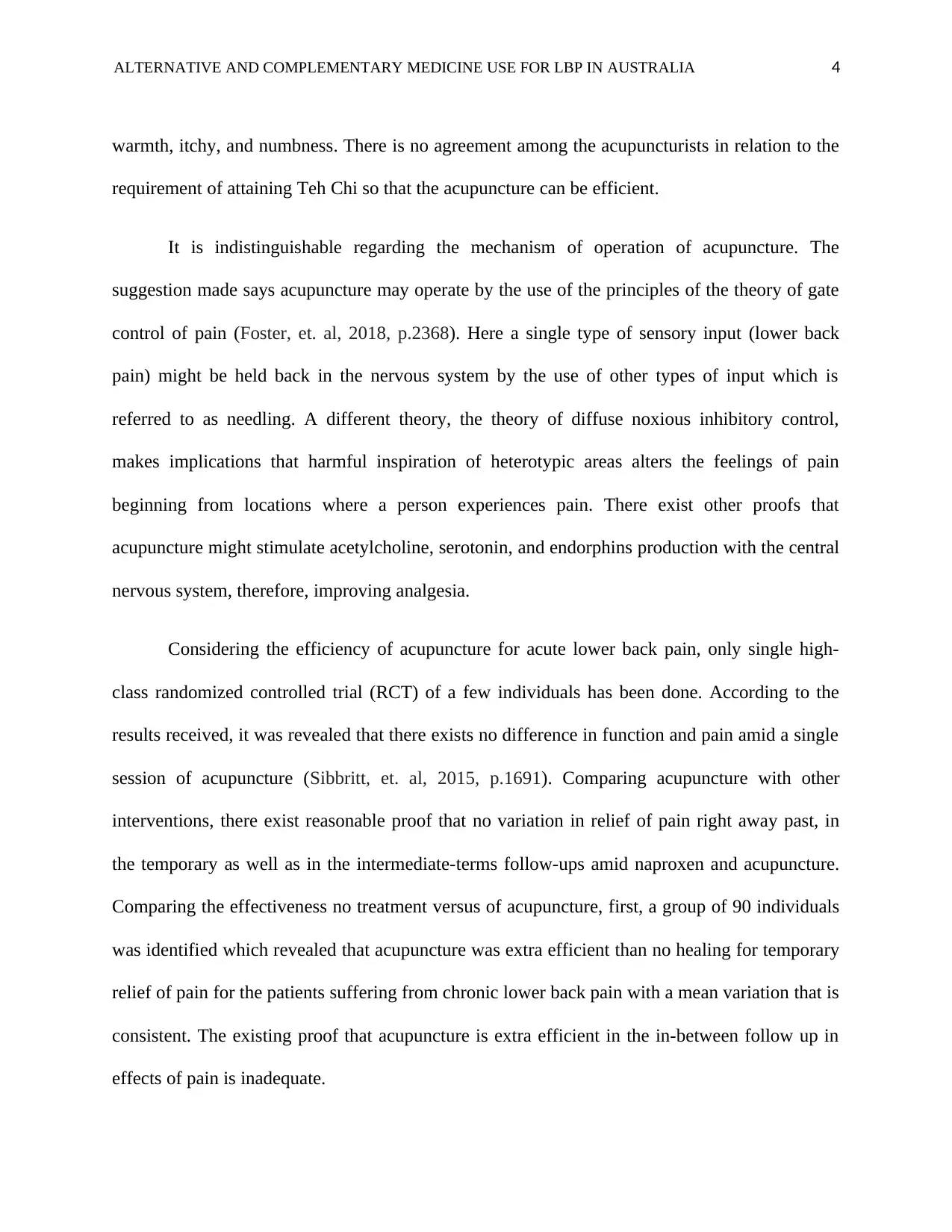
ALTERNATIVE AND COMPLEMENTARY MEDICINE USE FOR LBP IN AUSTRALIA 4
warmth, itchy, and numbness. There is no agreement among the acupuncturists in relation to the
requirement of attaining Teh Chi so that the acupuncture can be efficient.
It is indistinguishable regarding the mechanism of operation of acupuncture. The
suggestion made says acupuncture may operate by the use of the principles of the theory of gate
control of pain (Foster, et. al, 2018, p.2368). Here a single type of sensory input (lower back
pain) might be held back in the nervous system by the use of other types of input which is
referred to as needling. A different theory, the theory of diffuse noxious inhibitory control,
makes implications that harmful inspiration of heterotypic areas alters the feelings of pain
beginning from locations where a person experiences pain. There exist other proofs that
acupuncture might stimulate acetylcholine, serotonin, and endorphins production with the central
nervous system, therefore, improving analgesia.
Considering the efficiency of acupuncture for acute lower back pain, only single high-
class randomized controlled trial (RCT) of a few individuals has been done. According to the
results received, it was revealed that there exists no difference in function and pain amid a single
session of acupuncture (Sibbritt, et. al, 2015, p.1691). Comparing acupuncture with other
interventions, there exist reasonable proof that no variation in relief of pain right away past, in
the temporary as well as in the intermediate-terms follow-ups amid naproxen and acupuncture.
Comparing the effectiveness no treatment versus of acupuncture, first, a group of 90 individuals
was identified which revealed that acupuncture was extra efficient than no healing for temporary
relief of pain for the patients suffering from chronic lower back pain with a mean variation that is
consistent. The existing proof that acupuncture is extra efficient in the in-between follow up in
effects of pain is inadequate.
warmth, itchy, and numbness. There is no agreement among the acupuncturists in relation to the
requirement of attaining Teh Chi so that the acupuncture can be efficient.
It is indistinguishable regarding the mechanism of operation of acupuncture. The
suggestion made says acupuncture may operate by the use of the principles of the theory of gate
control of pain (Foster, et. al, 2018, p.2368). Here a single type of sensory input (lower back
pain) might be held back in the nervous system by the use of other types of input which is
referred to as needling. A different theory, the theory of diffuse noxious inhibitory control,
makes implications that harmful inspiration of heterotypic areas alters the feelings of pain
beginning from locations where a person experiences pain. There exist other proofs that
acupuncture might stimulate acetylcholine, serotonin, and endorphins production with the central
nervous system, therefore, improving analgesia.
Considering the efficiency of acupuncture for acute lower back pain, only single high-
class randomized controlled trial (RCT) of a few individuals has been done. According to the
results received, it was revealed that there exists no difference in function and pain amid a single
session of acupuncture (Sibbritt, et. al, 2015, p.1691). Comparing acupuncture with other
interventions, there exist reasonable proof that no variation in relief of pain right away past, in
the temporary as well as in the intermediate-terms follow-ups amid naproxen and acupuncture.
Comparing the effectiveness no treatment versus of acupuncture, first, a group of 90 individuals
was identified which revealed that acupuncture was extra efficient than no healing for temporary
relief of pain for the patients suffering from chronic lower back pain with a mean variation that is
consistent. The existing proof that acupuncture is extra efficient in the in-between follow up in
effects of pain is inadequate.
Paraphrase This Document
Need a fresh take? Get an instant paraphrase of this document with our AI Paraphraser
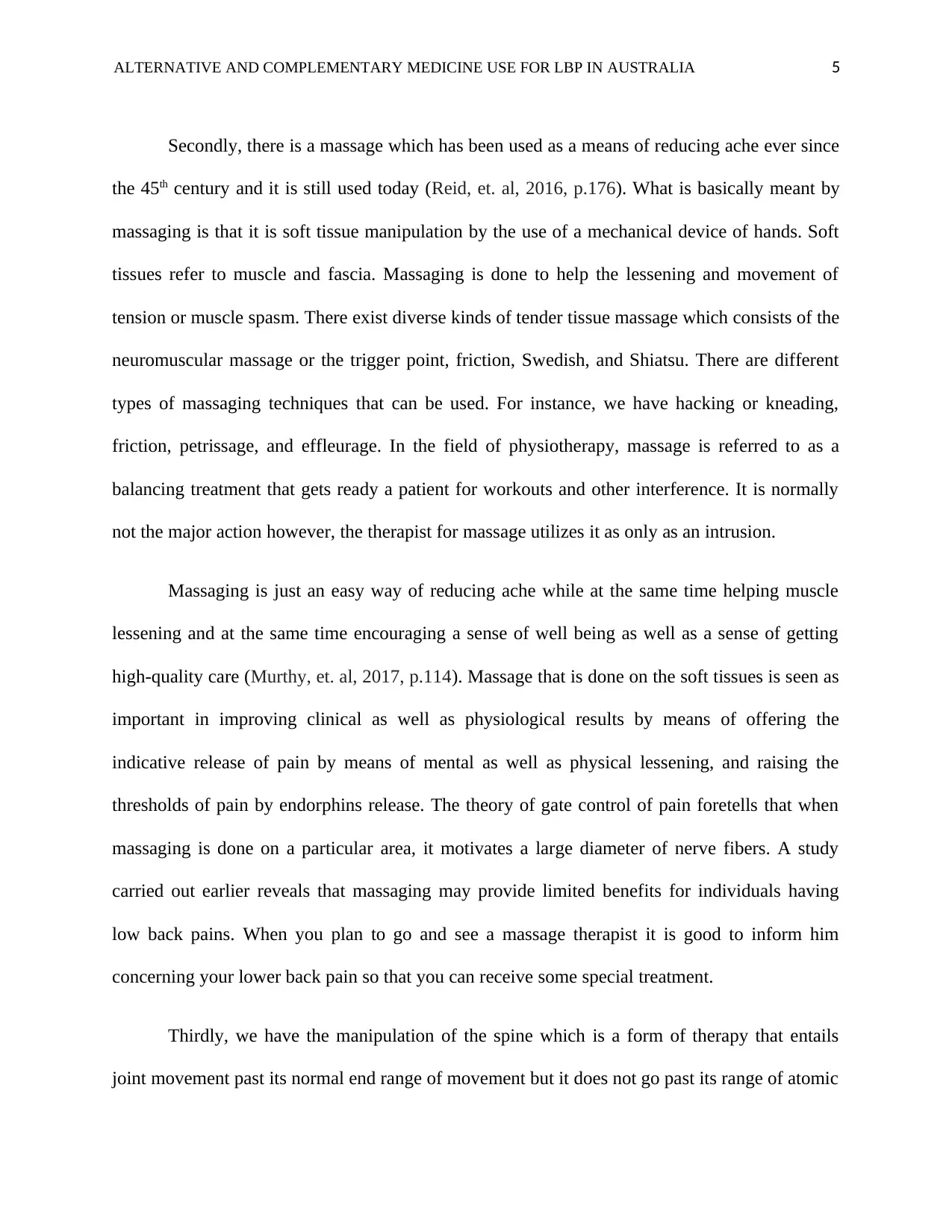
ALTERNATIVE AND COMPLEMENTARY MEDICINE USE FOR LBP IN AUSTRALIA 5
Secondly, there is a massage which has been used as a means of reducing ache ever since
the 45th century and it is still used today (Reid, et. al, 2016, p.176). What is basically meant by
massaging is that it is soft tissue manipulation by the use of a mechanical device of hands. Soft
tissues refer to muscle and fascia. Massaging is done to help the lessening and movement of
tension or muscle spasm. There exist diverse kinds of tender tissue massage which consists of the
neuromuscular massage or the trigger point, friction, Swedish, and Shiatsu. There are different
types of massaging techniques that can be used. For instance, we have hacking or kneading,
friction, petrissage, and effleurage. In the field of physiotherapy, massage is referred to as a
balancing treatment that gets ready a patient for workouts and other interference. It is normally
not the major action however, the therapist for massage utilizes it as only as an intrusion.
Massaging is just an easy way of reducing ache while at the same time helping muscle
lessening and at the same time encouraging a sense of well being as well as a sense of getting
high-quality care (Murthy, et. al, 2017, p.114). Massage that is done on the soft tissues is seen as
important in improving clinical as well as physiological results by means of offering the
indicative release of pain by means of mental as well as physical lessening, and raising the
thresholds of pain by endorphins release. The theory of gate control of pain foretells that when
massaging is done on a particular area, it motivates a large diameter of nerve fibers. A study
carried out earlier reveals that massaging may provide limited benefits for individuals having
low back pains. When you plan to go and see a massage therapist it is good to inform him
concerning your lower back pain so that you can receive some special treatment.
Thirdly, we have the manipulation of the spine which is a form of therapy that entails
joint movement past its normal end range of movement but it does not go past its range of atomic
Secondly, there is a massage which has been used as a means of reducing ache ever since
the 45th century and it is still used today (Reid, et. al, 2016, p.176). What is basically meant by
massaging is that it is soft tissue manipulation by the use of a mechanical device of hands. Soft
tissues refer to muscle and fascia. Massaging is done to help the lessening and movement of
tension or muscle spasm. There exist diverse kinds of tender tissue massage which consists of the
neuromuscular massage or the trigger point, friction, Swedish, and Shiatsu. There are different
types of massaging techniques that can be used. For instance, we have hacking or kneading,
friction, petrissage, and effleurage. In the field of physiotherapy, massage is referred to as a
balancing treatment that gets ready a patient for workouts and other interference. It is normally
not the major action however, the therapist for massage utilizes it as only as an intrusion.
Massaging is just an easy way of reducing ache while at the same time helping muscle
lessening and at the same time encouraging a sense of well being as well as a sense of getting
high-quality care (Murthy, et. al, 2017, p.114). Massage that is done on the soft tissues is seen as
important in improving clinical as well as physiological results by means of offering the
indicative release of pain by means of mental as well as physical lessening, and raising the
thresholds of pain by endorphins release. The theory of gate control of pain foretells that when
massaging is done on a particular area, it motivates a large diameter of nerve fibers. A study
carried out earlier reveals that massaging may provide limited benefits for individuals having
low back pains. When you plan to go and see a massage therapist it is good to inform him
concerning your lower back pain so that you can receive some special treatment.
Thirdly, we have the manipulation of the spine which is a form of therapy that entails
joint movement past its normal end range of movement but it does not go past its range of atomic
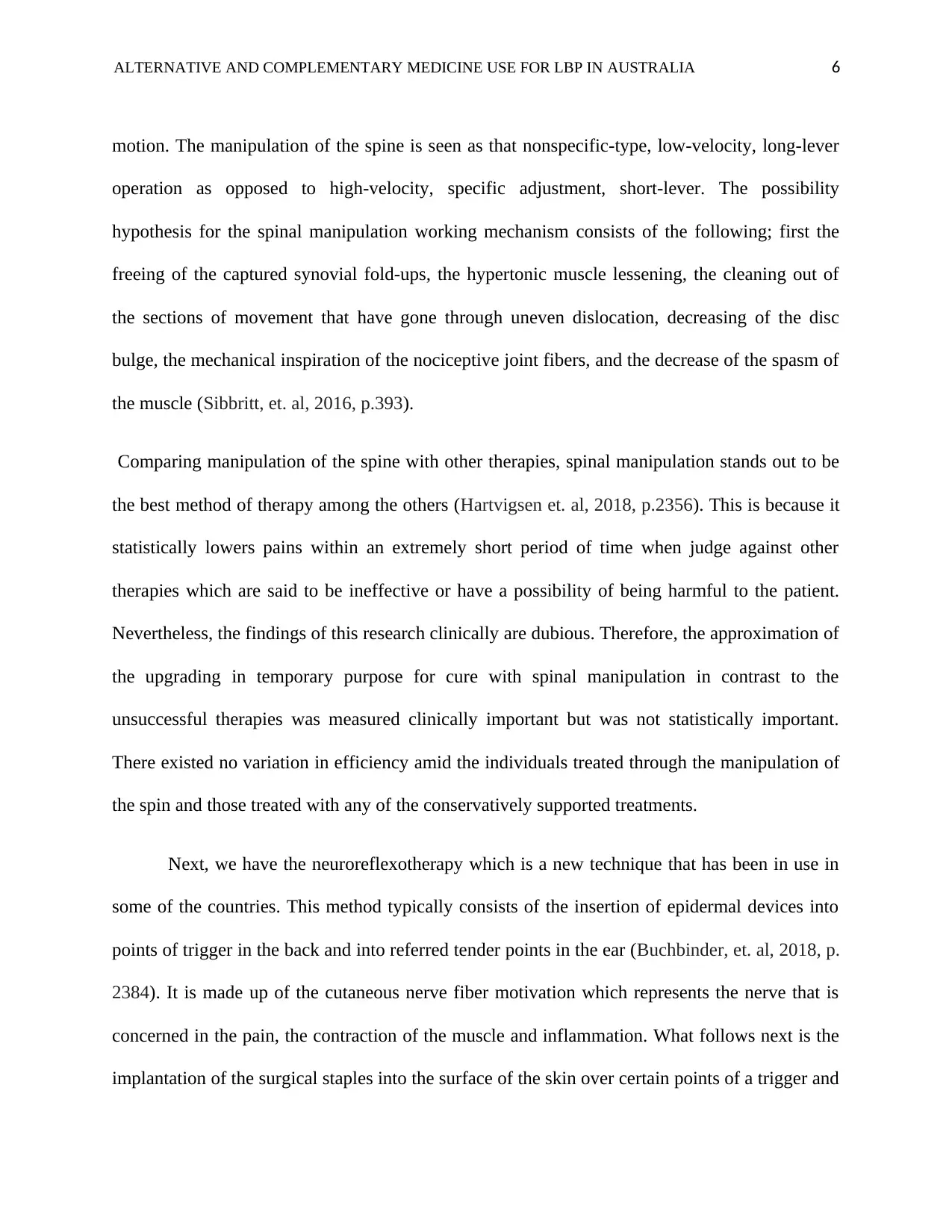
ALTERNATIVE AND COMPLEMENTARY MEDICINE USE FOR LBP IN AUSTRALIA 6
motion. The manipulation of the spine is seen as that nonspecific-type, low-velocity, long-lever
operation as opposed to high-velocity, specific adjustment, short-lever. The possibility
hypothesis for the spinal manipulation working mechanism consists of the following; first the
freeing of the captured synovial fold-ups, the hypertonic muscle lessening, the cleaning out of
the sections of movement that have gone through uneven dislocation, decreasing of the disc
bulge, the mechanical inspiration of the nociceptive joint fibers, and the decrease of the spasm of
the muscle (Sibbritt, et. al, 2016, p.393).
Comparing manipulation of the spine with other therapies, spinal manipulation stands out to be
the best method of therapy among the others (Hartvigsen et. al, 2018, p.2356). This is because it
statistically lowers pains within an extremely short period of time when judge against other
therapies which are said to be ineffective or have a possibility of being harmful to the patient.
Nevertheless, the findings of this research clinically are dubious. Therefore, the approximation of
the upgrading in temporary purpose for cure with spinal manipulation in contrast to the
unsuccessful therapies was measured clinically important but was not statistically important.
There existed no variation in efficiency amid the individuals treated through the manipulation of
the spin and those treated with any of the conservatively supported treatments.
Next, we have the neuroreflexotherapy which is a new technique that has been in use in
some of the countries. This method typically consists of the insertion of epidermal devices into
points of trigger in the back and into referred tender points in the ear (Buchbinder, et. al, 2018, p.
2384). It is made up of the cutaneous nerve fiber motivation which represents the nerve that is
concerned in the pain, the contraction of the muscle and inflammation. What follows next is the
implantation of the surgical staples into the surface of the skin over certain points of a trigger and
motion. The manipulation of the spine is seen as that nonspecific-type, low-velocity, long-lever
operation as opposed to high-velocity, specific adjustment, short-lever. The possibility
hypothesis for the spinal manipulation working mechanism consists of the following; first the
freeing of the captured synovial fold-ups, the hypertonic muscle lessening, the cleaning out of
the sections of movement that have gone through uneven dislocation, decreasing of the disc
bulge, the mechanical inspiration of the nociceptive joint fibers, and the decrease of the spasm of
the muscle (Sibbritt, et. al, 2016, p.393).
Comparing manipulation of the spine with other therapies, spinal manipulation stands out to be
the best method of therapy among the others (Hartvigsen et. al, 2018, p.2356). This is because it
statistically lowers pains within an extremely short period of time when judge against other
therapies which are said to be ineffective or have a possibility of being harmful to the patient.
Nevertheless, the findings of this research clinically are dubious. Therefore, the approximation of
the upgrading in temporary purpose for cure with spinal manipulation in contrast to the
unsuccessful therapies was measured clinically important but was not statistically important.
There existed no variation in efficiency amid the individuals treated through the manipulation of
the spin and those treated with any of the conservatively supported treatments.
Next, we have the neuroreflexotherapy which is a new technique that has been in use in
some of the countries. This method typically consists of the insertion of epidermal devices into
points of trigger in the back and into referred tender points in the ear (Buchbinder, et. al, 2018, p.
2384). It is made up of the cutaneous nerve fiber motivation which represents the nerve that is
concerned in the pain, the contraction of the muscle and inflammation. What follows next is the
implantation of the surgical staples into the surface of the skin over certain points of a trigger and
⊘ This is a preview!⊘
Do you want full access?
Subscribe today to unlock all pages.

Trusted by 1+ million students worldwide
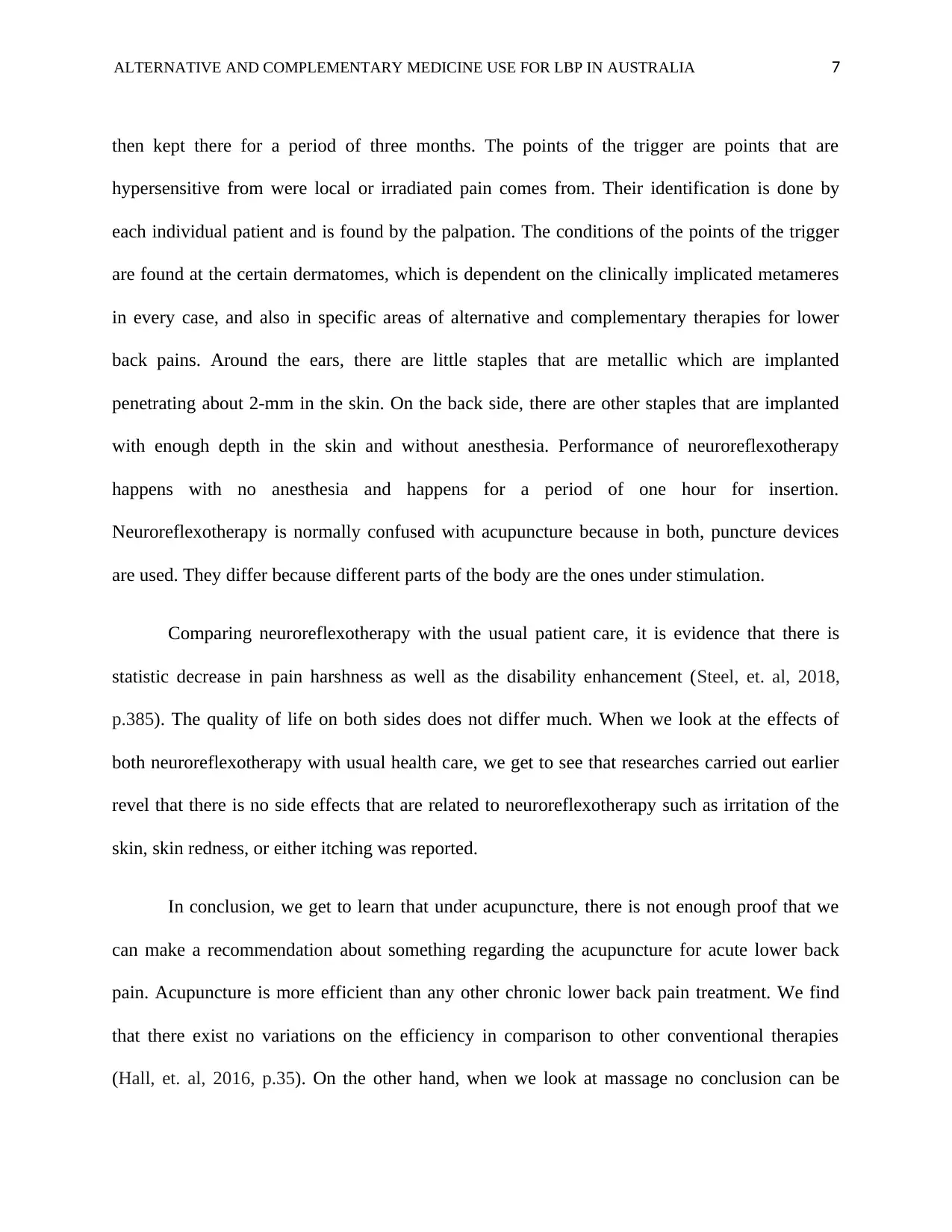
ALTERNATIVE AND COMPLEMENTARY MEDICINE USE FOR LBP IN AUSTRALIA 7
then kept there for a period of three months. The points of the trigger are points that are
hypersensitive from were local or irradiated pain comes from. Their identification is done by
each individual patient and is found by the palpation. The conditions of the points of the trigger
are found at the certain dermatomes, which is dependent on the clinically implicated metameres
in every case, and also in specific areas of alternative and complementary therapies for lower
back pains. Around the ears, there are little staples that are metallic which are implanted
penetrating about 2-mm in the skin. On the back side, there are other staples that are implanted
with enough depth in the skin and without anesthesia. Performance of neuroreflexotherapy
happens with no anesthesia and happens for a period of one hour for insertion.
Neuroreflexotherapy is normally confused with acupuncture because in both, puncture devices
are used. They differ because different parts of the body are the ones under stimulation.
Comparing neuroreflexotherapy with the usual patient care, it is evidence that there is
statistic decrease in pain harshness as well as the disability enhancement (Steel, et. al, 2018,
p.385). The quality of life on both sides does not differ much. When we look at the effects of
both neuroreflexotherapy with usual health care, we get to see that researches carried out earlier
revel that there is no side effects that are related to neuroreflexotherapy such as irritation of the
skin, skin redness, or either itching was reported.
In conclusion, we get to learn that under acupuncture, there is not enough proof that we
can make a recommendation about something regarding the acupuncture for acute lower back
pain. Acupuncture is more efficient than any other chronic lower back pain treatment. We find
that there exist no variations on the efficiency in comparison to other conventional therapies
(Hall, et. al, 2016, p.35). On the other hand, when we look at massage no conclusion can be
then kept there for a period of three months. The points of the trigger are points that are
hypersensitive from were local or irradiated pain comes from. Their identification is done by
each individual patient and is found by the palpation. The conditions of the points of the trigger
are found at the certain dermatomes, which is dependent on the clinically implicated metameres
in every case, and also in specific areas of alternative and complementary therapies for lower
back pains. Around the ears, there are little staples that are metallic which are implanted
penetrating about 2-mm in the skin. On the back side, there are other staples that are implanted
with enough depth in the skin and without anesthesia. Performance of neuroreflexotherapy
happens with no anesthesia and happens for a period of one hour for insertion.
Neuroreflexotherapy is normally confused with acupuncture because in both, puncture devices
are used. They differ because different parts of the body are the ones under stimulation.
Comparing neuroreflexotherapy with the usual patient care, it is evidence that there is
statistic decrease in pain harshness as well as the disability enhancement (Steel, et. al, 2018,
p.385). The quality of life on both sides does not differ much. When we look at the effects of
both neuroreflexotherapy with usual health care, we get to see that researches carried out earlier
revel that there is no side effects that are related to neuroreflexotherapy such as irritation of the
skin, skin redness, or either itching was reported.
In conclusion, we get to learn that under acupuncture, there is not enough proof that we
can make a recommendation about something regarding the acupuncture for acute lower back
pain. Acupuncture is more efficient than any other chronic lower back pain treatment. We find
that there exist no variations on the efficiency in comparison to other conventional therapies
(Hall, et. al, 2016, p.35). On the other hand, when we look at massage no conclusion can be
Paraphrase This Document
Need a fresh take? Get an instant paraphrase of this document with our AI Paraphraser
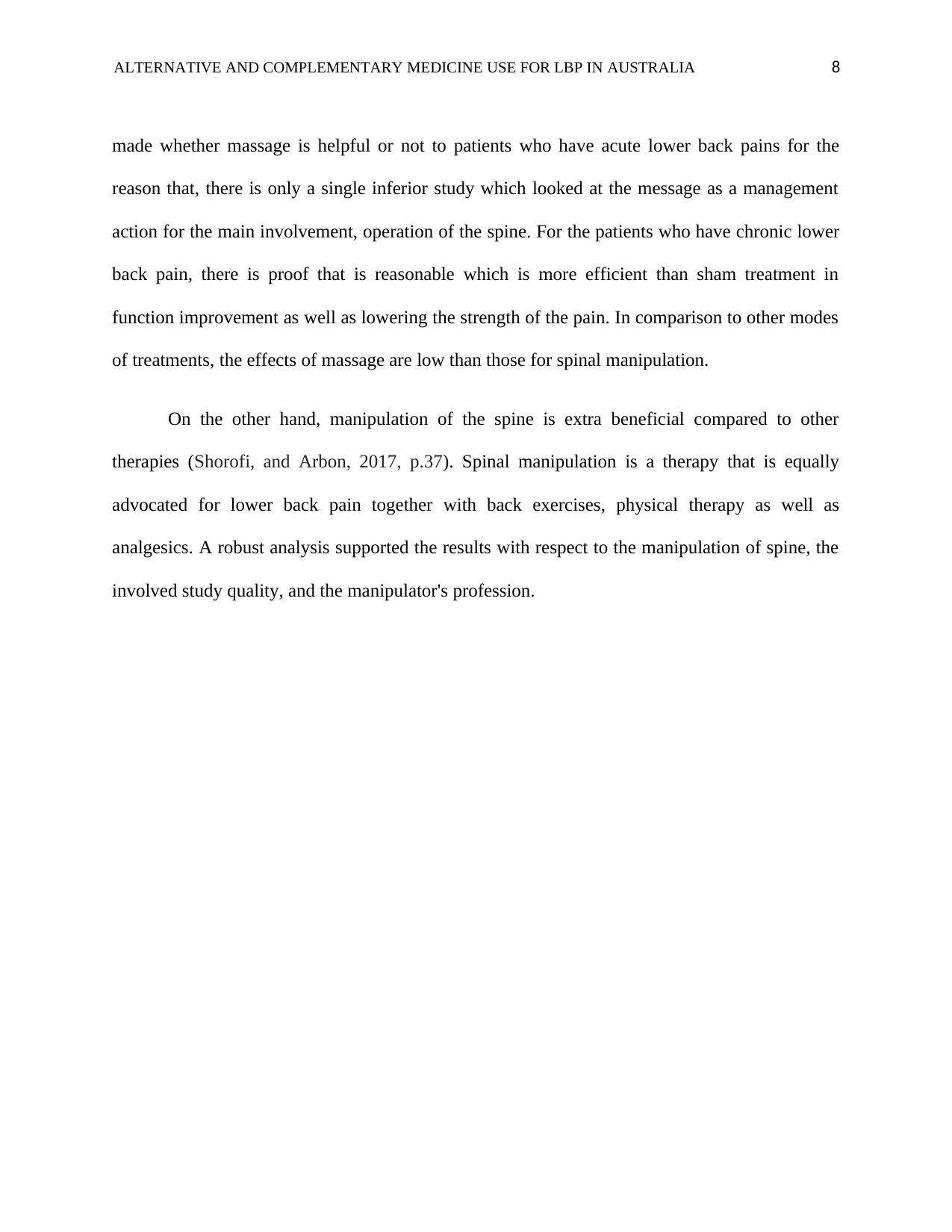
ALTERNATIVE AND COMPLEMENTARY MEDICINE USE FOR LBP IN AUSTRALIA 8
made whether massage is helpful or not to patients who have acute lower back pains for the
reason that, there is only a single inferior study which looked at the message as a management
action for the main involvement, operation of the spine. For the patients who have chronic lower
back pain, there is proof that is reasonable which is more efficient than sham treatment in
function improvement as well as lowering the strength of the pain. In comparison to other modes
of treatments, the effects of massage are low than those for spinal manipulation.
On the other hand, manipulation of the spine is extra beneficial compared to other
therapies (Shorofi, and Arbon, 2017, p.37). Spinal manipulation is a therapy that is equally
advocated for lower back pain together with back exercises, physical therapy as well as
analgesics. A robust analysis supported the results with respect to the manipulation of spine, the
involved study quality, and the manipulator's profession.
made whether massage is helpful or not to patients who have acute lower back pains for the
reason that, there is only a single inferior study which looked at the message as a management
action for the main involvement, operation of the spine. For the patients who have chronic lower
back pain, there is proof that is reasonable which is more efficient than sham treatment in
function improvement as well as lowering the strength of the pain. In comparison to other modes
of treatments, the effects of massage are low than those for spinal manipulation.
On the other hand, manipulation of the spine is extra beneficial compared to other
therapies (Shorofi, and Arbon, 2017, p.37). Spinal manipulation is a therapy that is equally
advocated for lower back pain together with back exercises, physical therapy as well as
analgesics. A robust analysis supported the results with respect to the manipulation of spine, the
involved study quality, and the manipulator's profession.
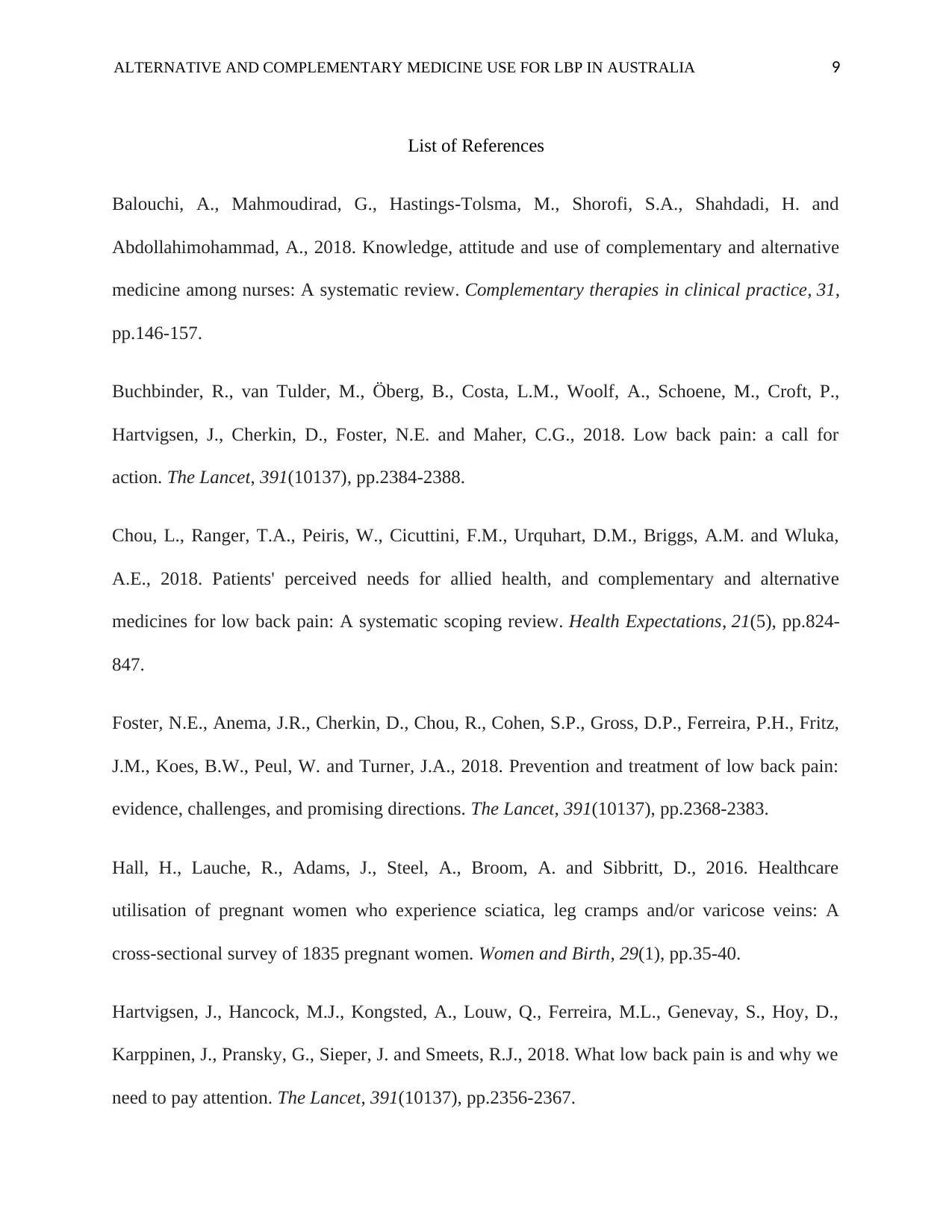
ALTERNATIVE AND COMPLEMENTARY MEDICINE USE FOR LBP IN AUSTRALIA 9
List of References
Balouchi, A., Mahmoudirad, G., Hastings-Tolsma, M., Shorofi, S.A., Shahdadi, H. and
Abdollahimohammad, A., 2018. Knowledge, attitude and use of complementary and alternative
medicine among nurses: A systematic review. Complementary therapies in clinical practice, 31,
pp.146-157.
Buchbinder, R., van Tulder, M., Öberg, B., Costa, L.M., Woolf, A., Schoene, M., Croft, P.,
Hartvigsen, J., Cherkin, D., Foster, N.E. and Maher, C.G., 2018. Low back pain: a call for
action. The Lancet, 391(10137), pp.2384-2388.
Chou, L., Ranger, T.A., Peiris, W., Cicuttini, F.M., Urquhart, D.M., Briggs, A.M. and Wluka,
A.E., 2018. Patients' perceived needs for allied health, and complementary and alternative
medicines for low back pain: A systematic scoping review. Health Expectations, 21(5), pp.824-
847.
Foster, N.E., Anema, J.R., Cherkin, D., Chou, R., Cohen, S.P., Gross, D.P., Ferreira, P.H., Fritz,
J.M., Koes, B.W., Peul, W. and Turner, J.A., 2018. Prevention and treatment of low back pain:
evidence, challenges, and promising directions. The Lancet, 391(10137), pp.2368-2383.
Hall, H., Lauche, R., Adams, J., Steel, A., Broom, A. and Sibbritt, D., 2016. Healthcare
utilisation of pregnant women who experience sciatica, leg cramps and/or varicose veins: A
cross-sectional survey of 1835 pregnant women. Women and Birth, 29(1), pp.35-40.
Hartvigsen, J., Hancock, M.J., Kongsted, A., Louw, Q., Ferreira, M.L., Genevay, S., Hoy, D.,
Karppinen, J., Pransky, G., Sieper, J. and Smeets, R.J., 2018. What low back pain is and why we
need to pay attention. The Lancet, 391(10137), pp.2356-2367.
List of References
Balouchi, A., Mahmoudirad, G., Hastings-Tolsma, M., Shorofi, S.A., Shahdadi, H. and
Abdollahimohammad, A., 2018. Knowledge, attitude and use of complementary and alternative
medicine among nurses: A systematic review. Complementary therapies in clinical practice, 31,
pp.146-157.
Buchbinder, R., van Tulder, M., Öberg, B., Costa, L.M., Woolf, A., Schoene, M., Croft, P.,
Hartvigsen, J., Cherkin, D., Foster, N.E. and Maher, C.G., 2018. Low back pain: a call for
action. The Lancet, 391(10137), pp.2384-2388.
Chou, L., Ranger, T.A., Peiris, W., Cicuttini, F.M., Urquhart, D.M., Briggs, A.M. and Wluka,
A.E., 2018. Patients' perceived needs for allied health, and complementary and alternative
medicines for low back pain: A systematic scoping review. Health Expectations, 21(5), pp.824-
847.
Foster, N.E., Anema, J.R., Cherkin, D., Chou, R., Cohen, S.P., Gross, D.P., Ferreira, P.H., Fritz,
J.M., Koes, B.W., Peul, W. and Turner, J.A., 2018. Prevention and treatment of low back pain:
evidence, challenges, and promising directions. The Lancet, 391(10137), pp.2368-2383.
Hall, H., Lauche, R., Adams, J., Steel, A., Broom, A. and Sibbritt, D., 2016. Healthcare
utilisation of pregnant women who experience sciatica, leg cramps and/or varicose veins: A
cross-sectional survey of 1835 pregnant women. Women and Birth, 29(1), pp.35-40.
Hartvigsen, J., Hancock, M.J., Kongsted, A., Louw, Q., Ferreira, M.L., Genevay, S., Hoy, D.,
Karppinen, J., Pransky, G., Sieper, J. and Smeets, R.J., 2018. What low back pain is and why we
need to pay attention. The Lancet, 391(10137), pp.2356-2367.
⊘ This is a preview!⊘
Do you want full access?
Subscribe today to unlock all pages.

Trusted by 1+ million students worldwide
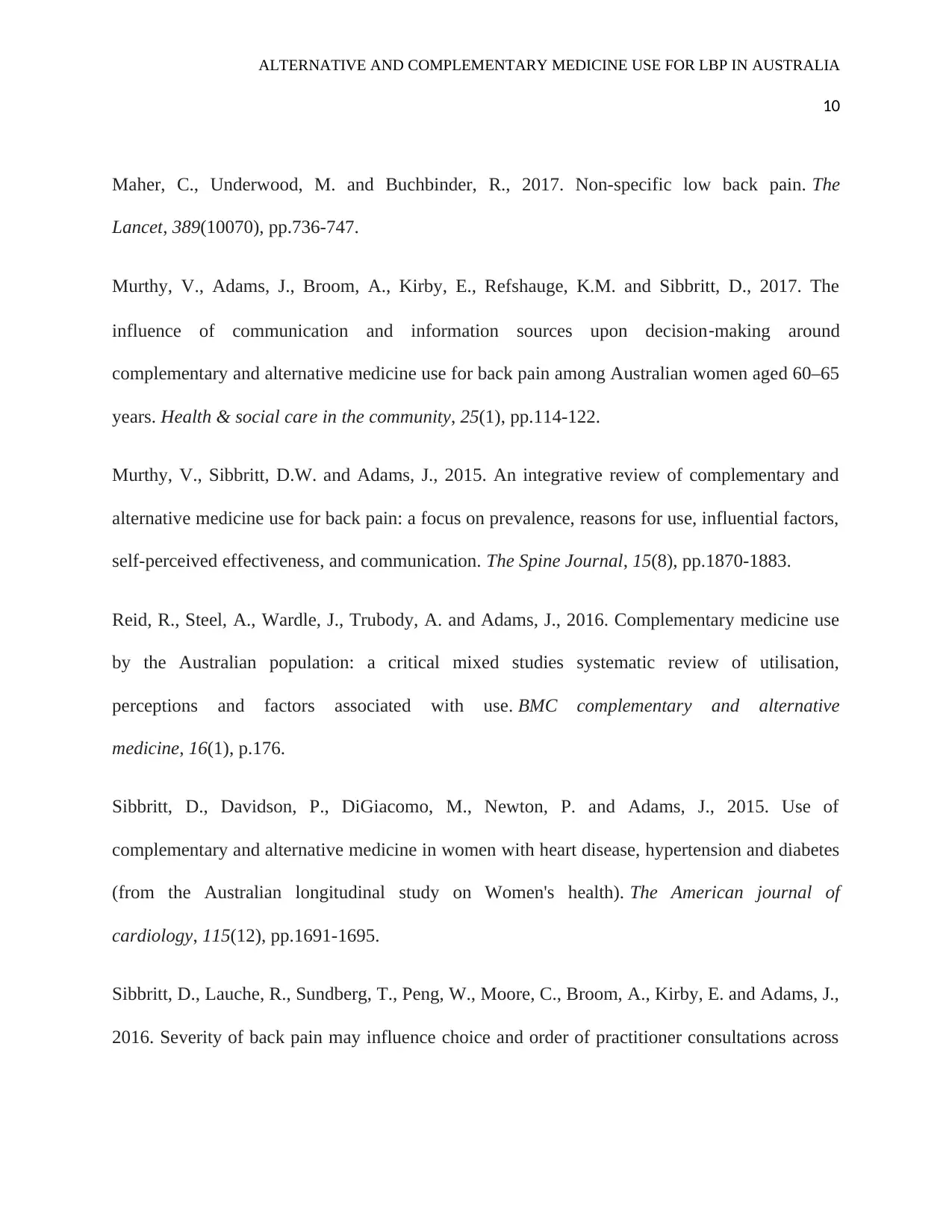
ALTERNATIVE AND COMPLEMENTARY MEDICINE USE FOR LBP IN AUSTRALIA
10
Maher, C., Underwood, M. and Buchbinder, R., 2017. Non-specific low back pain. The
Lancet, 389(10070), pp.736-747.
Murthy, V., Adams, J., Broom, A., Kirby, E., Refshauge, K.M. and Sibbritt, D., 2017. The
influence of communication and information sources upon decision‐making around
complementary and alternative medicine use for back pain among Australian women aged 60–65
years. Health & social care in the community, 25(1), pp.114-122.
Murthy, V., Sibbritt, D.W. and Adams, J., 2015. An integrative review of complementary and
alternative medicine use for back pain: a focus on prevalence, reasons for use, influential factors,
self-perceived effectiveness, and communication. The Spine Journal, 15(8), pp.1870-1883.
Reid, R., Steel, A., Wardle, J., Trubody, A. and Adams, J., 2016. Complementary medicine use
by the Australian population: a critical mixed studies systematic review of utilisation,
perceptions and factors associated with use. BMC complementary and alternative
medicine, 16(1), p.176.
Sibbritt, D., Davidson, P., DiGiacomo, M., Newton, P. and Adams, J., 2015. Use of
complementary and alternative medicine in women with heart disease, hypertension and diabetes
(from the Australian longitudinal study on Women's health). The American journal of
cardiology, 115(12), pp.1691-1695.
Sibbritt, D., Lauche, R., Sundberg, T., Peng, W., Moore, C., Broom, A., Kirby, E. and Adams, J.,
2016. Severity of back pain may influence choice and order of practitioner consultations across
10
Maher, C., Underwood, M. and Buchbinder, R., 2017. Non-specific low back pain. The
Lancet, 389(10070), pp.736-747.
Murthy, V., Adams, J., Broom, A., Kirby, E., Refshauge, K.M. and Sibbritt, D., 2017. The
influence of communication and information sources upon decision‐making around
complementary and alternative medicine use for back pain among Australian women aged 60–65
years. Health & social care in the community, 25(1), pp.114-122.
Murthy, V., Sibbritt, D.W. and Adams, J., 2015. An integrative review of complementary and
alternative medicine use for back pain: a focus on prevalence, reasons for use, influential factors,
self-perceived effectiveness, and communication. The Spine Journal, 15(8), pp.1870-1883.
Reid, R., Steel, A., Wardle, J., Trubody, A. and Adams, J., 2016. Complementary medicine use
by the Australian population: a critical mixed studies systematic review of utilisation,
perceptions and factors associated with use. BMC complementary and alternative
medicine, 16(1), p.176.
Sibbritt, D., Davidson, P., DiGiacomo, M., Newton, P. and Adams, J., 2015. Use of
complementary and alternative medicine in women with heart disease, hypertension and diabetes
(from the Australian longitudinal study on Women's health). The American journal of
cardiology, 115(12), pp.1691-1695.
Sibbritt, D., Lauche, R., Sundberg, T., Peng, W., Moore, C., Broom, A., Kirby, E. and Adams, J.,
2016. Severity of back pain may influence choice and order of practitioner consultations across
Paraphrase This Document
Need a fresh take? Get an instant paraphrase of this document with our AI Paraphraser
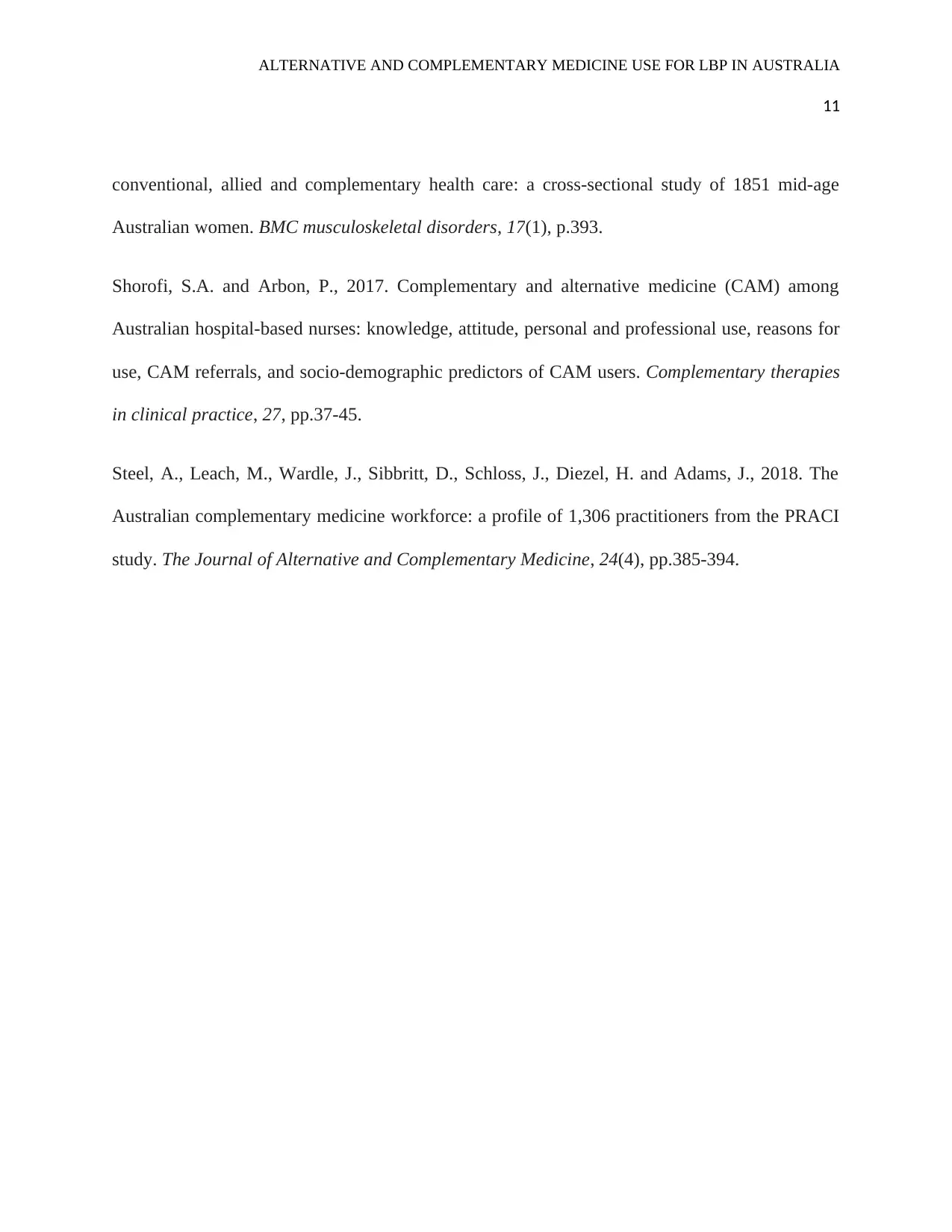
ALTERNATIVE AND COMPLEMENTARY MEDICINE USE FOR LBP IN AUSTRALIA
11
conventional, allied and complementary health care: a cross-sectional study of 1851 mid-age
Australian women. BMC musculoskeletal disorders, 17(1), p.393.
Shorofi, S.A. and Arbon, P., 2017. Complementary and alternative medicine (CAM) among
Australian hospital-based nurses: knowledge, attitude, personal and professional use, reasons for
use, CAM referrals, and socio-demographic predictors of CAM users. Complementary therapies
in clinical practice, 27, pp.37-45.
Steel, A., Leach, M., Wardle, J., Sibbritt, D., Schloss, J., Diezel, H. and Adams, J., 2018. The
Australian complementary medicine workforce: a profile of 1,306 practitioners from the PRACI
study. The Journal of Alternative and Complementary Medicine, 24(4), pp.385-394.
11
conventional, allied and complementary health care: a cross-sectional study of 1851 mid-age
Australian women. BMC musculoskeletal disorders, 17(1), p.393.
Shorofi, S.A. and Arbon, P., 2017. Complementary and alternative medicine (CAM) among
Australian hospital-based nurses: knowledge, attitude, personal and professional use, reasons for
use, CAM referrals, and socio-demographic predictors of CAM users. Complementary therapies
in clinical practice, 27, pp.37-45.
Steel, A., Leach, M., Wardle, J., Sibbritt, D., Schloss, J., Diezel, H. and Adams, J., 2018. The
Australian complementary medicine workforce: a profile of 1,306 practitioners from the PRACI
study. The Journal of Alternative and Complementary Medicine, 24(4), pp.385-394.
1 out of 11
Related Documents
Your All-in-One AI-Powered Toolkit for Academic Success.
+13062052269
info@desklib.com
Available 24*7 on WhatsApp / Email
![[object Object]](/_next/static/media/star-bottom.7253800d.svg)
Unlock your academic potential
Copyright © 2020–2025 A2Z Services. All Rights Reserved. Developed and managed by ZUCOL.





